Small boat sailing rigs
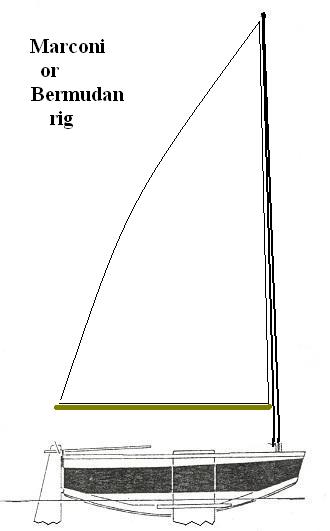
The modern Marconi or Bermudan rig.
~ ~ ~ ~ ~ ~ ~ ~ ~ ~ ~ ~ ~ ~ ~ ~ ~ ~ ~ ~ ~ ~ ~ ~ ~ ~ ~ ~ ~ ~ ~ ~ ~ ~ ~ ~ ~
There are several different styles of Lug sail plans
~ ~ ~
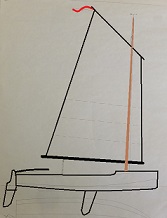
Balanced Lug with boom forward of mast
 - - - -
- - - -
 - - - -
- - - - 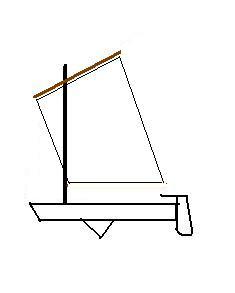
Dipping Lug has no boom and the tack is fastened forward of the mast - - - - Standing lug with boom, tack fastened to forward end of boom - - Standing lug with no boom

The Chinese Lug is an ancient fully battened lug rig
There are sheetlets which gather the strain from the leech ends
averaging them out through a wooden block called an eupharoe. to gather them all to a single sheet (line)
to control the angle of the whole sail.
This boom is supported by lazy jacks on both sides so that if one slacks off on the halyard
and lowers the sail any amount the sail will be gathered on the boom with no fuss or bother and
and effectively be infinitely reef-able to any amount, not being constrained by reef points.
~ ~ ~
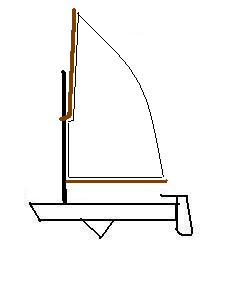
The Gunter or Sliding Gunter rig is sometimes classed with the Lug rigs, but
I could see that it has relationships with both the Marconi and Gaff rigs.
~ ~ ~ ~ ~ ~ ~ ~ ~ ~ ~ ~ ~ ~ ~ ~ ~ ~ ~ ~ ~ ~ ~ ~ ~ ~ ~ ~ ~ ~ ~ ~ ~ ~ ~ ~ ~
The Gaff rig
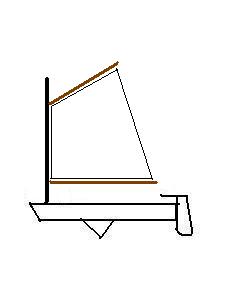
When without a jib this rig is often found on catboats, which are common in northeastern USA.
When a gaff sail is used with a jib one has a traditional sloop rig.
The head of the sail is attached to the Gaff. The Gaff meets the mast and a forked end holds it in place.
Most of the time there are 2 halyards, one to hold the throat (mast end) of the Gaff up and
a peaking halyard which lifts the outboard end of the Gaff.
~ ~ ~ ~ ~ ~ ~ ~ ~ ~ ~ ~ ~ ~ ~ ~ ~ ~ ~ ~ ~ ~ ~ ~ ~ ~ ~ ~ ~ ~ ~ ~ ~ ~ ~ ~ ~
The Sprit rig
 - -
- - 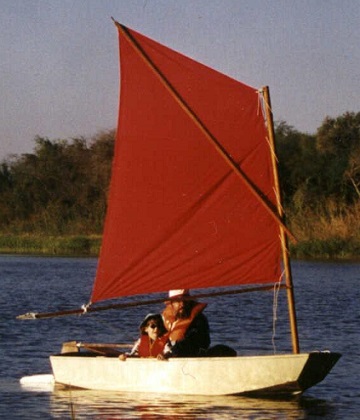
~ ~ ~
- a sprit on a jib -

A very unusual situation - The Jib with the clew held out by a sprit
This photo found in the historical museum in Port Aransas, Texas, USA.
~ ~ ~ ~ ~ ~ ~ ~ ~ ~ ~ ~ ~ ~ ~ ~ ~ ~ ~ ~ ~ ~ ~ ~ ~ ~ ~ ~ ~ ~ ~ ~ ~ ~ ~ ~ ~
2 versions of the Leg-o-Mutton sail
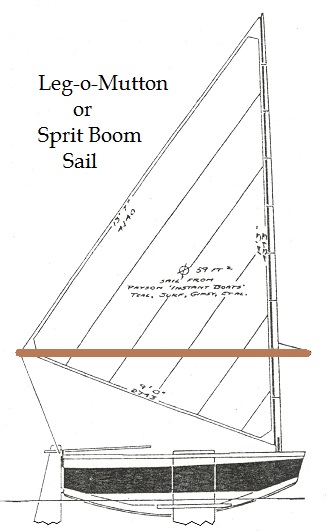
One of the rigs I intend to use with my recently built dingy is the Leg-o-Mutton rig
- also known as a Sprit Boom rig - this example from P. Bolger and H. Payson
the brown pole is the Sprit Boom.
The part of the sail below the sprit acts to prevent the boom from rising.
~ ~ ~
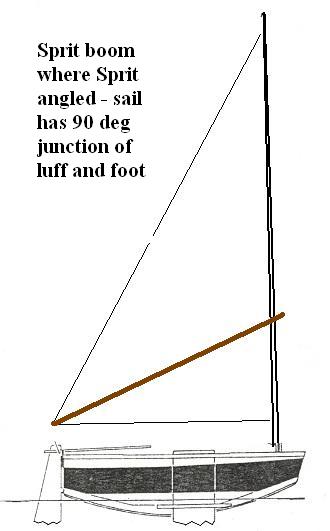
In some variations the angle of the sail luff foot are closer to a right angle (90 degrees) and
sprit is fastened with the snotter higher on the mast and it angles down to the clew.
The Core Sound CS17 uses this rig, as does the Bay River Skiff by B and B Yacht Designs.
~ ~ ~
Another variation of this rig is the Wishbone rig where there are 2 sprits joined forward of the mast
Gary Hoyt used this on his Freedom 40
and other designs of the larger Freedom series.
~ ~ ~ ~ ~ ~ ~ ~ ~ ~ ~ ~ ~ ~ ~ ~ ~ ~ ~ ~ ~ ~ ~ ~ ~ ~ ~ ~ ~ ~ ~ ~ ~ ~ ~ ~ ~
 - - - -
- - - - 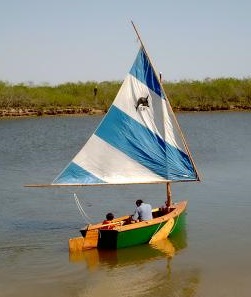
Lateen sail without a boom - - - - - - - - lateen sail with boom
Feluccas in Egypt have booms - - - Dhows in the Indian Ocean are most commonly rigged without booms.
Some of these sails have their lower fore corner truncated.
As a point of technicality these would be more properly called Settee sails.
~ ~ ~
Variations include the Crab Claw sail used in the Pacific particularly on the large ocean going Polynesian catamarans.
~ ~ ~ ~ ~ ~ ~ ~ ~ ~ ~ ~ ~ ~ ~ ~ ~ ~ ~ ~ ~ ~ ~ ~ ~ ~ ~ ~ ~ ~ ~ ~ ~ ~ ~ ~ ~
-
update 18 March 2017 - 16 March 2018 -
Sailing Rigs - index page
Boat Building Index page